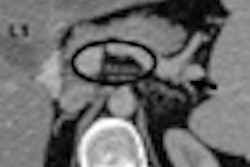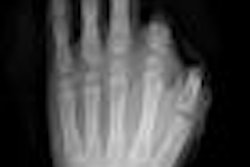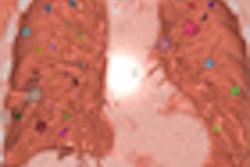Patients who undergo repeated coronary artery calcium (CAC) scans may be setting themselves up for a cancer diagnosis, according to a new study that estimated the risks but not the potential benefits of CAC scan protocols and frequencies.
At the high end of the risk estimates, as many as 42 of every 100,000 patients screened for calcium could develop radiation-induced cancer if they were scanned every five years from ages 45 to 75, the study concluded.
That's a whole lot of scans, of course, and quite a young age to start them. And the authors did note that estimated risk dropped substantially for individuals scanned just once, or for those with repeated scans at very low doses.
But the less alarming risk profile associated with a single scan wasn't enough to mollify a cardiac radiologist who commented on the study for AuntMinnie.com. Dr. U. Joseph Schoepf from the Medical University of South Carolina in Charleston blasted the paper as "cheap, sensationalist, self-serving, and ultimately not helpful." Similar to previous studies that have wielded unprovable cancer death estimates, Schoepf said, "not a single patient was scanned for this investigation."
The authors of the present study, Kwang Po Kim, Ph.D., and Amy Berrington Gonzales, Ph.D., are from the National Institutes of Health (NIH) in Bethesda, MD. Dr. Andrew Einstein, Ph.D., is an assistant professor of clinical medicine in radiology at Columbia University in New York City.
The new data constitute important information to inform researchers, as well as patients, and should be included in future risk/benefit calculations, concluded the authors of the study and those of an accompanying editorial in the Archives of Internal Medicine (July 13, 2009, Vol. 169:3, pp. 1188-1194 and pp. 1184-1187, respectively).
"These radiation risk estimates can be compared with potential benefits from screening, when such estimates are available," Kim and colleagues wrote.
The study
MDCT, which has been proposed to screen for coronary artery calcium in asymptomatic middle-aged adults and older, could involve the screening of millions of adults. However, detailed estimates of radiation doses and potential risks are unavailable, Kim and colleagues wrote.
According to a recent survey, 27% of diagnostic radiologists already read CAC scans regularly, making it the most common type of CT scan performed in the U.S. Screening for Heart Attack Prevention and Education (SHAPE) guidelines recommend screening of all asymptomatic men 45 to 75 years of age except those defined as very low risk.
Therefore, the researchers aimed to estimate "organ-specific radiation doses and associated cancer risks from coronary artery calcifications screened with MDCT according to patients' age, frequency of screening, and scan protocol."
The study calculated radiation doses to adult patients from a variety of protocols using Monte Carlo radiation transport. International Commission on Radiological Protection (ICRP) publication 103 tissue-weighting factors were used to calculate the effective doses.
"We considered CT scan protocols that were established by some national cardiac studies and by one international study on standardization in cardiac CT," along with protocols used at three university hospitals.
Radiation risk models derived from Japanese atomic bomb survivor and medically exposed cohorts developed by the BEIR VII commission combined with organ-specific dose estimates were then used to estimate the excess lifetime risk of radiation-induced cancers. Potential risks were estimated according to gender and age at screening.
The estimated doses varied widely from 0.8 to 10.5 mSv per screening for a mean and median of 2.3 mSv and 3.1 mSv, respectively.
"In general, higher radiation doses were associated with higher x-ray tube current, higher tube potential, spiral scanning with low pitch, and retrospective gating," they wrote. Many factors affected the dose including scanner model, x-ray tube potential, and electrocardiogram gating. The wide variation led to similar variation in estimated cancer risks.
Assuming a scan every five years from ages 45 to 75 for men and 55 to 75 for women, the estimated excess lifetime cancer risk at a median dose of 2.3 mSv was 42 cases per 100,000 men (range, 14-200 cases) and 62 cases per 100,000 women (range, 21-300 cases). The estimated risk for all cancers was higher for women than for men because lung cancer was estimated at twofold higher for women than men.
A single screening at age 40 was estimated to result in a lifetime cancer risk of nine (range, 3-42) and 28 (range, 9-130) cancers per 100,000 individuals (men and women, respectively).
The largest proportion of the estimated radiation-induced cancer incidence, 72% and 71% for men and women, respectively, was attributable to lung cancer, followed by breast cancer for women (20%) and then leukemia (12% and 4% for men and women, respectively), they wrote.
The broader the population to be scanned, the greater the potential impact; therefore, "it is essential to optimize calcium scoring protocols to minimize dose while maintaining adequate image quality to yield a reliable calcium score," the authors wrote.
"While the International Consortium has recently recommended that protocols should be standardized, to date it has only published protocols for a limited number of scanners, including few current-generation scanners," they wrote. "Further efforts by professional societies are necessary to standardize protocols."
That said, there are significant sources of uncertainty in radiation risk assessment "owing to the lack of precision in the parameter estimates and uncertain assumptions, such as the form of dose-response relationship at low doses," they wrote. "In the present study, the extrapolation was performed under the linear no-threshold assumption, with a dose and dose-rate effectiveness factor of 1.5. However, there is also epidemiological and radiobiological evidence that supports both downwardly and upwardly curving slopes, and these alternatives to the BEIR VII risk models would result in higher or lower estimates, respectively."
The risks can be compared with estimates of the benefits of calcium screening once they become available, to help design appropriate screening and prevention strategies for coronary artery disease. However, there are no widely agreed-upon protocols for CAC screening, and dose variations are wide.
"Careful optimization of these factors may reduce radiation exposure without detriment to the clinical purpose of the screening examination," they wrote.
Editorial
An accompanying editorial by Dr. Raymond Gibbons and Dr. Thomas Gerber from the Mayo Clinic in Rochester, MN, noted that an accurate assessment of the risks, benefits, and costs of coronary artery calcium screening remains an elusive goal -- one that is advanced, nevertheless, by the present study.
Most of the published information relates to coronary CT angiography (CTA), which, for a number of technical reasons, generally provides much higher doses.
"It is disquieting that there is no standard protocol for the quantification of CAC," they wrote, a situation that may result from overconfidence in the value of the exam. The interscan variability of CAC measurements is "crucially relevant for the serial assessment of CAC scans, for which the intraindividual variability must be less than the expected progression of CAC scores over a given period of time." Standardization could potentially reduce that variability, they noted.
In addition to using the commonly accepted Monte Carlo simulations, Kim and colleagues are among the first to use the newest set of organ-weighing factors and methodological recommendations provided by the ICRP. Compared with studies that use the older recommendations, the radiation dose estimates of the present study are approximately 30% to 50% higher, a change that reflects new definitions and methodology rather than actual radiation exposures, they noted.
The study is also worthy of merit for having estimated the exposure from a single scan in addition to serial screening exams, since repeated scans are a particular concern.
"There are convincing data that the presence and quantity of CAC have predictive value for adverse cardiac events, ranging form a relative risk of 1.9 at the low end of the range of CAC scores to a relative risk of 10.8 at the high end," Gibbons and Gerber wrote. "However, because the overall risk of major adverse events is generally low in the general population (< 10% over 10 years), the absolute event rate, i.e., the positive predictive value, is low for any specific cutoff of CAC."
Advocates of CAC screening argue that knowledge of the presence and severity of CAC will improve treatment compliance; however, a recent Army study found that case management was a far better predictor of patients' attitudes toward cardiovascular health and behaviors.
Moreover, studies using serial CAC scans have had variable success in predicting CAC progression, and as a result, organizations have discouraged the type of serial scanning modeled by Kim and colleagues.
The study has two implications: First, previous cost-effectiveness analyses have not accounted for potential cancer risk, and they need to do so, according to Gibbons and Gerber. Consent forms and future research protocols should also incorporate the researcher's data.
Second, professional organizations should advocate for standardized CAC scoring protocols with CT. In the meantime, dose should be minimized while balancing image quality sufficient for confident interpretation per current American Heart Association (AHA) guidelines, the editorialists wrote.
"Physicians dedicated to the practice of evidence-based medicine should carefully review the American College of Cardiology and AHA clinical practice guidelines on the detection of asymptomatic coronary artery disease that are currently being prepared and will be published late in 2009 or early in 2010 to inform their clinical judgment regarding the suitability of CAC scoring for individual patients," they wrote. "For patients in whom CAC scoring is considered, healthcare providers should ideally discuss the potential risks and benefits of the procedure."
A radiologist comments
"Can we stop already? This current piece is just a faint afterthought of [a] previous publication ... aimed at coronary CTA," wrote Schoepf, a professor of radiology and medicine at Medical University of South Carolina, in an e-mail to AuntMinnie.com. "Once again, putative scan protocols were gleaned from the literature and clinical practices were assumed that do not reflect clinical reality."
No patients were scanned for this study, he said. But based on nonapplicable extrapolations from atomic bomb survivors, the researchers estimated cancer risk based on the putative protocols calculated using the BEIR VII algorithm.
"A middle school student with a pocket calculator can do the same type of number crunching," Schoepf wrote. "There is no point estimating risk if the benefit is lost out of sight. Although hard data on improved outcome from coronary artery calcium scoring is difficult to obtain, it is safe to assume that improved risk management in patients who undergo this test with proper indications vastly outweighs the hypothetical cancer risk."
Although data on improved patient outcome from calcium scoring are scarce, the data do exist and are convincing enough to have resulted in the endorsement of this test by relevant professional societies, Schoepf wrote. On the other hand, the hypothesis that the level of radiation received during medical imaging bears cancer risk is an assumption that does not have any published literature to support it.
It is not appropriate to calculate a "median" dose from various protocols that are published in the literature, Schoepf continued. An effective radiation equivalent of more than 10 mSv is certainly excessive for the purpose of coronary artery calcium scoring and, one hopes, is not widely used. With prospective electrocardiogram triggering, the radiation dose from calcium scoring should not exceed 1-2 mSv, he said.
Like the authors of the previous publication in JAMA, this study assumes an unrealistically young age for its calculations, i.e., 40 years, in order for their assumptions to result in sensationalist high cancer risk numbers, according to Schoepf. Risk-stratification frameworks such as the Multi-Ethnic Study of Atherosclerosis (MESA) don't even offer the option of calculating risk at such a young age, he said. Thus, the authors based their assumptions on improper indication of this test.
"It is questionable whether serial screening every five years is a clinical reality," Schoepf wrote. "This approach seems more gleaned from colon cancer screening, for which five- year intervals are recommended. Again, it seems that the authors strive to choose assumptions that serve their desired results, rather than aiming at reflecting clinical reality."
Author responds
In an e-mail to AuntMinnie.com, study author Andrew Einstein responded to Schoepf's criticism of the study.
First, he wrote, the epidemiologic models used in the study were based on those of the National Academies BEIR VII committee, with in addition current data from the Surveillance, Epidemiology, and End Results (SEER) Program cancer registries used to estimate risks to the "other solid cancers" organs referenced in the study.
"While we discussed several potential limitations of the approach used, the modeling in our study represents state-of-the-art cancer risk modeling, performed by my colleague who holds a D.Phil. from Oxford from one of the world's preeminent radiation epidemiology groups," he wrote. "Thus, I believe that its characterization as being 'middle school' is clearly incorrect. In fact, I have personally been contacted by Dr. Schoepf's group in the past, requesting advice on the performance of such modeling."
The protocols used were not putative, but real protocols for average-sized patients including those specified at all sites in the CARDIA and MESA studies, International Consortium recommendations, and protocols used here at Columbia University Medical Center/New York-Presbyterian Hospital and by expert colleagues at other outstanding medical centers, Einstein wrote.
As found in the PROTECTION II for CT coronary angiography, there was a high degree of variability in effective dose between typical dose. The authors intent in using the protocol with median effective dose for cancer risk estimation was in fact to minimize the effect of outliers on these estimates.
Schoepf also incorrectly claims the use of an unrealistically young model for the calculations, Einstein wrote. Calculations were performed for all ages between 40 and 80 and the range of cancer risk estimates were reported, with no emphasis on either extreme.
"In terms of the benefits of coronary artery calcium scoring, as a clinician and imager I find it to be a great test for risk stratification of properly selected patients, and fully concur with the 2006 AHA Scientific Statement and 2007 ACCF/AHA expert consensus document that it 'may be reasonable' to consider calcium scoring in patients with intermediate risk of coronary heart disease risk," Einstein wrote. "In such patients, I believe that in general the radiation-associated risk will be far outweighed by the benefits of improved risk stratification."
Of late, more attention has been drawn to coronary artery calcium scoring as a screening test for larger populations beyond this intermediate-risk group, Einstein wrote. This has been proposed in the SHAPE guidelines, which propose screening patients every 5-10 years, and in a new Texas law that will mandate payers to cover calcium scoring for a population broader than these intermediate-risk patients.
"In such scenarios, comprehensive evaluation of benefits, risks, and costs, by physicians or policymakers, should include assessment of potential radiation risks; one goal of our study was to provide this piece of the equation," Einstein wrote.
By Eric Barnes
AuntMinnie.com staff writer
July 13, 2009
Related Reading
High-pitch cardiothoracic CTA skips breath-holds and high doses, July 7, 2009
Triple-rule-out CT scans benefit from prospective gating, May 28, 2009
Tube current modulation cuts triple rule-out CTA dose, April 15, 2009
JAMA study finds wide variation in cardiac CTA dose, February 3, 2009
AHA science advisory warns about cardiac imaging dose, February 3, 2009
Copyright © 2009 AuntMinnie.com



















